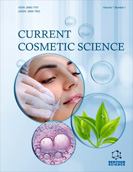Abstract
Background: Sericin is a hydrophilic and adhesive protein that provides structural integrity to the silkworm cocoon.
Objective: The study aimed to develop sericin isolated from Indian BV mulberry silk cocoons as a cosmetic raw material and study its sensory impact.
Methods: Sericin was isolated using high-temperature and high-pressure techniques without the use of chemicals. Native and hydrolyzed sericin were studied for suitability in cosmetic formulations. Lastly, their safety was established using a primary irritation patch test in twenty-four healthy volunteers, and the impact of sericin on skin care formulation was studied.
Results: Both native and hydrolyzed sericin were studied for their application in personal care products. Native sericin was difficult to process due to its gelling behavior. Hydrolyzed sericin was readily formulated in skin lotion and was found to be stable for 3 months under accelerated conditions. Sericin and its formulations did not cause any skin irritation and were found to be well-tolerated. Formulation with 0.01% w/w hydrolyzed sericin was best accepted among the panelists.
Conclusion: The study establishes the use of sericin isolated from mulberry silkworms as a sensory enhancer for skin care applications.
[http://dx.doi.org/10.1038/168745a0] [PMID: 14882336]
[http://dx.doi.org/10.1155/2016/8175701] [PMID: 27965981]
[http://dx.doi.org/10.1016/j.cbpb.2007.01.009] [PMID: 17350301]
[http://dx.doi.org/10.1002/app.29925]
[http://dx.doi.org/10.1016/j.jclepro.2018.08.286]
[http://dx.doi.org/10.1016/j.ijbiomac.2010.09.008] [PMID: 20875446]
[http://dx.doi.org/10.1016/j.memsci.2008.09.020]
[http://dx.doi.org/10.1016/j.jclepro.2013.03.016]
[http://dx.doi.org/10.1242/jcs.089516] [PMID: 22215855]
[http://dx.doi.org/10.3181/00379727-32-8182C]
[http://dx.doi.org/10.4028/www.scientific.net/AMR.796.416]
[http://dx.doi.org/10.1111/j.1473-2165.2005.00200.x] [PMID: 17168872]
[http://dx.doi.org/10.1002/jctb.6441]
[http://dx.doi.org/10.1016/j.jbiosc.2008.12.012] [PMID: 19393558]
[http://dx.doi.org/10.5483/BMBRep.2008.41.3.236] [PMID: 18377728]
[http://dx.doi.org/10.1111/j.1745-4514.2008.00204.x]
[http://dx.doi.org/10.1016/S1011-1344(03)00092-7] [PMID: 14705634]
[http://dx.doi.org/10.1016/S0734-9750(02)00003-4] [PMID: 14538058]
[http://dx.doi.org/10.1042/BA20090186] [PMID: 20055756]
[http://dx.doi.org/10.1177/1091581820966953] [PMID: 33203267]
[http://dx.doi.org/10.1016/j.clindermatol.2008.04.004] [PMID: 18691510]
[http://dx.doi.org/10.9734/BJAST/2015/14975]
[http://dx.doi.org/10.1111/j.1468-2494.2009.00490.x] [PMID: 19570099]








